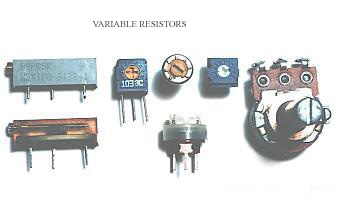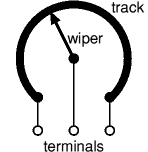Variable Resistors – Working and Applications
This article clearly defines
and explains the working of variable resistors, the variable resistance
specification, types, and applications.
Variable resistors find its application
in most of the electronic circuits used today. We have been getting a
lot of comments with questions on how a variable resistor works and so
on. Here are the details.
TAKE A LOOK : WORKING OF RESISTORS
 |
| Types of Variable resistors |
What is a Variable Resistor?
A variable resistor is a device that is
used to change the resistance according to our needs in an electronic
circuit. It can be used as a three terminal as well as a two terminal
device. Mostly they are used as a three terminal device. Variable
resistors are mostly used for device calibration.
Working of Variable Resistor
As shown in the diagram below, a
variable resistor consists of a track which provides the resistance
path. Two terminals of the device are connected to both the ends of the
track. The third terminal is connected to a wiper that decides the
motion of the track. The motion of the wiper through the track helps in
increasing and decreasing the resistance.
 |
| Variable Resistors |
The track is usually made of a mixture
of ceramic and metal or can be made of carbon as well. As a resistive
material is needed, carbon film type variable resistors are mostly used.
They find applications in radio receiver circuits, audio amplifier
circuits and TV receivers. For applications of small resistances, the
resistance track may just be a coil of wire. The track can be in both
the rotary as well as straight versions. In a rotary track some of them
may include a switch. The switch will have an operating shaft which can
be easily moved in the axial direction with one of its ends moving from
the body of variable resistor switch.
The rotary track resistor with has two
applications. One is to change the resistance. The switch mechanism is
used for the electric contact and non-contact by on/off operation of the
switch. There are switch mechanism variable resistors with annular
cross-section which are used for the control of equipments. Even more
components are added onto this type of a variable resistor so as to make
them compatible for complicated electronic circuits. A high-voltage
variable resistor such as a focus pack is an example. This device is
capable of producing a variable focus voltage as well as a screen
voltage. It is also connected to a variable resistance circuit and also a
fixed resistance circuit [bleeder resistor] to bring a change in the
applied voltage. For this both the fixed and variable resistor are
connected in series.
A track made in a straight path is
called a slider. As the position of a slider cannot be seen or confirmed
according to the adjustment of resistance, a stopping mechanism is
usually included to prevent the hazards caused due to over rotation.
Variable Resistance Specification
Various parameters like size, type of
track and also resistance is used to define a variable resistance.
Usually the spindle diameter of a variable resistor is 6mm.
If the variable resistor has a straight track it is defined in the component by the short form LIN representing a linear track. If it is a rotary track it is represented in short as LOG, as for a logarithmic track.
A common representation is given below.
5K6 LIN – 5.6 kilo ohm with a linear track.
2M LOG – 2 Mega ohm with a logarithmic track.
If the variable resistor has a straight track it is defined in the component by the short form LIN representing a linear track. If it is a rotary track it is represented in short as LOG, as for a logarithmic track.
A common representation is given below.
5K6 LIN – 5.6 kilo ohm with a linear track.
2M LOG – 2 Mega ohm with a logarithmic track.
In a linear track variable
resistor, as the wiper is moved along the track the resistance varies
constantly. In such resistors, the specification may not be given on the
type. In that case, you will have to assume that it is linear.
In a logarithmic track
variable resistor, the resistance does not increase/decrease constantly.
As the wiper is moved from one end, the resistance changes at a slower
rate and when the wiper is brought to the other end, the resistance
changes at a fatser rate. This means that when the wiper is at halfway
along the track, the resistance is not half the value of the total
resistance. This is specifically applied for volume control as the
response of the human ear to sound is also logarithmic. That is, a slow
change in the beginning and a rapid change towards the end.
Application of Variable Resistors
There are mainly three types of variable resistors. They are
- Potentiometer
- Rheostat
- Presets

No comments:
Post a Comment